Janome Memory Craft 6300 Professional Instruction Manual
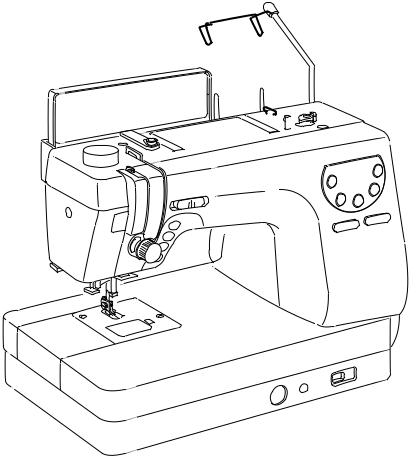
INSTRUCTION BOOK

IMPORTANT SAFETY INSTRUCTIONS
This appliance is not intended for use by persons (including children) with reduced physical, sensory or mental capabilities, or lack of experience and knowledge, unless they have been given supervision or instruction concerning use of the appliance by a person responsible for their safety.
Children should be supervised to ensure that they do not play with this sewing machine.
When using an electrical appliance, basic safety precautions should always be followed, including the following:
This sewing machine is designed and manufactured for household use only.
Read all instructions before using this sewing machine.
DANGER— To reduce the risk of electric shock:
1.An appliance should never be left unattended when plugged in. Always unplug this sewing machine from the electric outlet immediately after using and before cleaning.
2.Always unplug before replacing a sewing machine bulb. Replace bulb with same type rated 12 Volts, 5 Watts.
WARNING—To reduce the risk of burns, fire, electric shock, or injury to persons: 1. Do not allow to be used as a toy. Close attention is necessary when this sewing machine is used
by or near children.
2. Use this appliance only for its intended use as described in this ownerʼs manual.
Use only attachments recommended by the manufacturer as contained in this ownerʼs manual. 3. Never operate this sewing machine if it has a damaged cord or plug, if it is not working properly, if
it has been dropped or damaged, or dropped into water.
Return this sewing machine to the nearest authorized dealer or service center for examination, repair, electrical or mechanical adjustment.
4. Never operate the appliance with any air opening blocked. Keep ventilation openings of this sewing machine and foot controller free from accumulation of lint, dust and loose cloth.
5. Never drop or insert any object into any opening. 6. Do not use outdoors.
7. Do not operate where aerosol (spray) products are being used or where oxygen is being administered.
8. To disconnect, turn all controls to the off (“O”) position, then remove plug from outlet. 9. Do not unplug by pulling on cord.To unplug, grasp the plug, not the cord.
10. Keep fingers away from all moving parts. Special care is required around the sewing machine needle and/or cutting blade.
11. Always use the proper needle plate.The wrong plate can cause the needle to break. 12. Do not use bent needles.
13. Do not pull or push fabric while stitching. It may deflect the needle causing it to break.
14. Switch this sewing machine off (“O”) when making any adjustment in the needle area, such as threading the needle, changing the needle, threading the bobbin or changing the presser foot, and the like.
15. Always unplug this sewing machine from the electrical outlet when removing covers, lubricating, or when making any other adjustments mentioned in this ownerʼs manual.
The design and specifications are subject to change without a prior notice.
SAVETHESE INSTRUCTIONS
 Please note that on disposal, this product must be safely recycled in accordance with relevant National
Please note that on disposal, this product must be safely recycled in accordance with relevant National
 legislation relating to electrical/electronic products. If in doubt please contact your retailer for guidance.
legislation relating to electrical/electronic products. If in doubt please contact your retailer for guidance.  (European Union only)
(European Union only)
OPERATING INSTRUCTION:
For appliances with a polarized plug (one blade wider than the other):
To reduce the risk of electric shock, this plug is intended to fit in a polarized outlet only one way.
If the plug does not fit fully in the outlet, reverse the plug.
If it still does not fit, contact a qualified electrician to install the proper outlet. Do not modify the plug in any way.
Foot Controller 21371 for use with this sewing machine.
Do’s and Don’ts
1.Always be aware of the up-and-down movement of the needle and do not turn your attention away from the machine while it is running.
2.When leaving the sewing machine unattended, the main switch of the machine must be switched off or the plug must be removed from the socket-outlet.
3.When servicing the sewing machine, or when removing covers or changing lamps, the machine must be disconnected from the power supply by removing the plug from the socket-outlet.
4.Do not place anything on the foot control, otherwise the machine will start inadvertently, or the control or motor may burn out.
5.The maximum permissible power for the sewing lamp bulb is 5 watts.
6.When using your sewing machine for the first time, place a piece of waste fabric under the presser foot and run the machine without thread for a few minutes. Wipe away any oil which may have appeared.
KNOW YOUR MACHINE |
|
Names of Parts ................................................................. |
2 |
Attaching the quick referencce board................................ |
2 |
Standard Accessories ....................................................... |
3 |
GETTING READY TO SEW |
|
Connecting the Power Supply ........................................... |
4 |
Controlling Sewing Speed ................................................. |
4 |
Speed control lever ...................................................... |
4 |
Foot control .................................................................. |
4 |
Function Buttons ............................................................... |
5 |
Raising and Lowering the Presser Foot ............................ |
7 |
Attaching the Knee Lifter ................................................... |
7 |
Variety of Presser Feet and Their Uses ............................ |
8 |
Changing the Presser Foot ............................................... |
9 |
Detaching and Attaching the Foot Holder ......................... |
9 |
Attaching the even feed foot ........................................... |
10 |
Attaching the darning foot P ............................................ |
10 |
Winding the Bobbin ......................................................... |
11 |
Removing the bobbin ................................................. |
11 |
Setting the spool of thread ......................................... |
11 |
Winding the bobbin .................................................... |
12 |
Inserting the bobbin ................................................... |
13 |
Threading the Machine ................................................... |
14 |
Automatic Needle Threader ............................................ |
16 |
Drawing Up the Bobbin Thread ....................................... |
17 |
Changing Needles........................................................... |
18 |
Fabric and Needle Chart ................................................. |
18 |
Balancing Thread Tension ............................................... |
19 |
Adjusting the Foot Pressure ............................................ |
20 |
Dropping the Feed Dog ................................................... |
20 |
BASIC STITCHES |
|
Straight Stitch .................................................................. |
21 |
To sew from the edge of thick fabric .......................... |
21 |
Securing seam ........................................................... |
21 |
Changing sewing direction ......................................... |
22 |
Using the cloth guide ................................................. |
22 |
Using the seam guide lines ........................................ |
22 |
Adjusting the needle drop position ............................. |
23 |
Adjusting the stitch length .......................................... |
23 |
Variety of the straight stitches .................................... |
24 |
Basting ............................................................................ |
25 |
Zigzag Stitch ................................................................... |
26 |
Adjusting the stitch width ........................................... |
26 |
Adjusting the stitch length .......................................... |
26 |
Variety of Overcasting Stitches ....................................... |
27 |
Zipper Sewing ................................................................. |
29 |
Rolled Hem ..................................................................... |
32 |
Shell Tucking ................................................................... |
32 |
Blind Hem........................................................................ |
33 |
UTILITY STITCHES |
|
Buttonholes ..................................................................... |
34 |
Variety of buttonholes ................................................ |
34 |
Sensor buttonholes .................................................... |
34 |
Double layer buttonhole ............................................. |
37 |
Corded buttonhole ..................................................... |
37 |
Changing buttonhole width ........................................ |
38 |
Changing buttonhole stitch density ............................ |
38 |
Automatic buttonhole ................................................. |
39 |
Button Sewing ................................................................. |
41 |
Darning............................................................................ |
42 |
To sew a shorter darning ............................................ |
43 |
To sew the same size darning .................................... |
43 |
To adjust the eveness of darning ............................... |
43 |
Tacking ............................................................................ |
44 |
To sew a shorter tack ................................................. |
44 |
To sew the same size tack ......................................... |
44 |
Eyelet .............................................................................. |
45 |
Adjusting the shape of an eyelet ................................ |
45 |
PATCHWORK AND QUILTING |
|
Patchwork ....................................................................... |
46 |
Patchwork stitches ..................................................... |
46 |
Quilting bar for the zigzag foot ................................... |
47 |
Freemotion quilting .................................................... |
47 |
Clasp stitch ................................................................ |
48 |
PATTERN PROGRAMMING AND DECORATIVE STITCHES
Programming a Pattern Combination .............................. |
49 |
Sewing the pattern combiantion from the beginning ..... |
49 |
Pattern combination with auto thread cutting ............. |
50 |
Elongation Sewing .......................................................... |
51 |
Fagoting .......................................................................... |
52 |
Smocking ........................................................................ |
52 |
Applique .......................................................................... |
53 |
Twin Needle Sewing........................................................ |
54 |
Correcting Distorted Patterns .......................................... |
56 |
Reviewing the Programmed Pattern Combination .......... |
57 |
Deleting a Pattern from the Programmed Combination .. |
57 |
Inserting a Pattern in the Programmed Combination ...... |
58 |
Duplicating a Pattern in the Programmed Combination .. |
58 |
Uniform Stitch Adjustment of the Programmed Patterns. 59 |
|
Uniform stitch adjustment after sewing the pattern |
|
combination ................................................................ |
59 |
Individual Stitch Adjustment of the Progarmmed Pattens ... |
60 |
CARE OF THE MACHINE |
|
Cleaning the Hook Race and Feed Dog ......................... |
61 |
Assembling the hook race .......................................... |
61 |
Replacing the Light Bulb ................................................. |
62 |
Problems and Warning Signals ....................................... |
63 |
Troubleshooting .............................................................. |
65 |
1
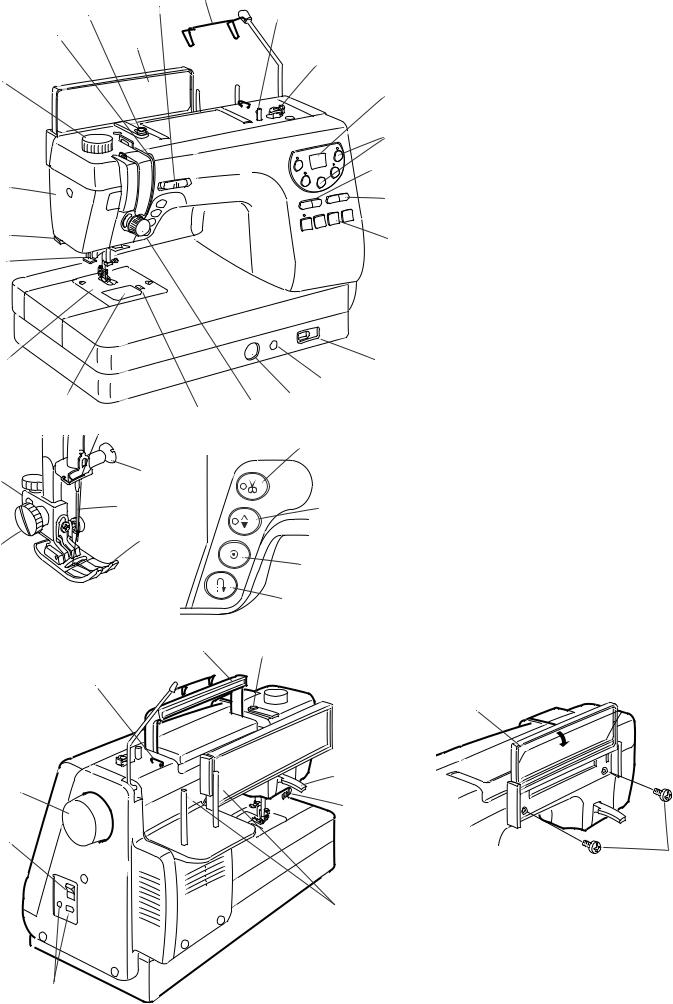
5 6
3
2
4
1
27
26
25
24
23
22
30  32
32
31
28
29
33
40
39
38
37
17
41
7
8
9
10
11
12
13
14
15
16
18
19
20
21
34
35
36
KNOW YOUR MACHINE
Name of Parts
1.Foot Pressure Dial
2.Thread Take-up Lever
3.Thread Guide
4.Quick Reference Board
5.Speed Control Lever
6.Retractable Thread Guide
7.Bobbin Winder Spindle
8.Bobbin Winder Stopper
9.LED Window
10.Function Buttons
11.Stitch Width Adjusting Button
12.Stitch Length Adjusting Button
13.Pattern Seleection Button
14.Drop Feed Lever
15.Knee Lifter Socket
16.Stitch Balance Adjusting Dial
17.Tension Regulating Dial
18.Thread Cutter Button
19.Up/Down Needle Button
20.Auto-Lock Button
21.Reverse Button
22.Hook Cover Plate Release Button
23.Hook Cover Plate
24.Needle Plate
25.Needle Threader
26.Thread Cutter
27.Face Plate
28.Zigzag Foot A
29.Thumb Screw
30.Foot Holder
31.Needle
32.Needle Clamp Screw
33.Carrying Handle
34.Presser Foot Lifter
35.Buttonhole Lever
36.Spool Pins
37.Machine Sockets
38.Power Switch
39.Handwheel
40.Thread Guide
41.Bobbin Winding Tension Disk
2
1
Attaching the quick reference board
The quick reference board and setscrews are included in the standard accessories.
Fix the quick reference board on the backside of the machine with the two setscrews.
Tighten the screws firmly with a screwdriver.
1Setscrews
2Quick Reference Board
2
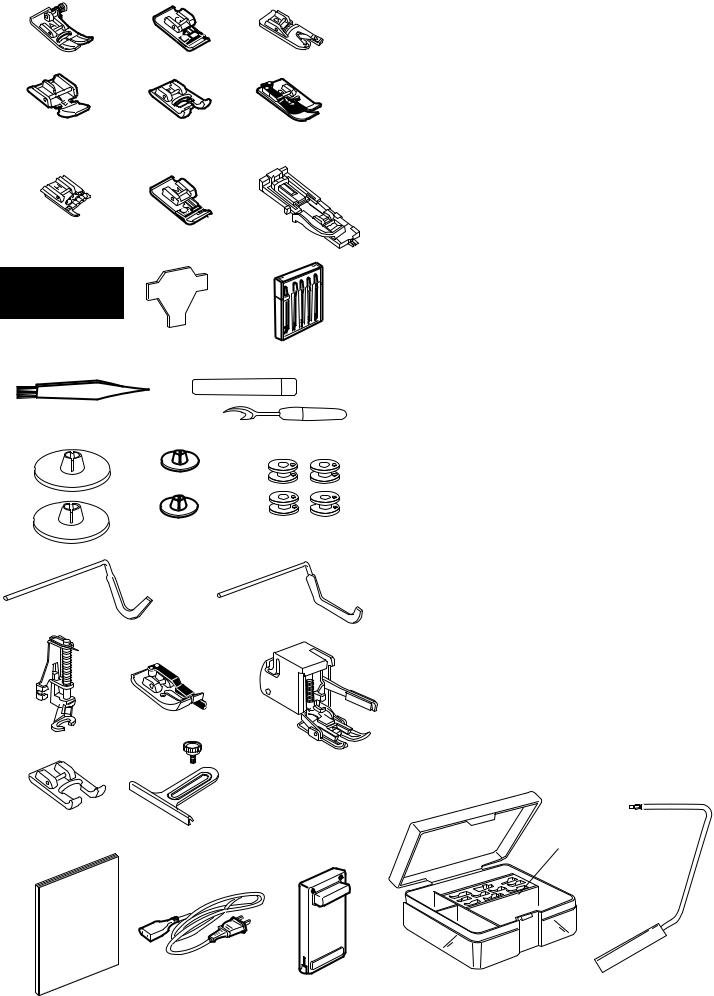
1
4
7
10
13
15
18
20
23
25
2
5
8
11
16
21
24
26
3
6
9
12
14
17
19
22
27
Standard Accessories
1.Zigzag Foot A (comes attached to the machine)
2.Overedge Foot C
3.Rolled Hem Foot D
4.Zipper Foot E
5.Satin Stitch Foot F
6.Blind Hem Foot G
7.Cording Foot H
8.Overcasting Foot M
9.Automatic Buttonhole Foot R
10.Screwdriver
11.Screwdriver
12.Set of Needles
13.Lint Brush
14.Seam Ripper
15.Spool Holder (Large)
16.Spool Holder (Small)
17.Bobbins
18.Quilting Bar
19.Quilting Bar for Even Feed Foot
20.Basting/Darning Foot P
21.1/4” Seam Foot O
22.Even Feed Foot
23.Open Toe Satin Stitch Foot F-2
24.Cloth Guide with Screw
25.Instruction Book
26.Power Supply Cord
27.Foot Control
28.Accessory Box
29.Foot Storage Compartment (marked with letters corresponding to the presser feet.)
30.Knee Lifter
30
28
29
3

1
 3
3
 4 3
4 3 

6 2
5
GETTING READY TO SEW
Connecting the Power Supply
Turn off the power switch.
Insert the foot control plug into the machine socket. Insert the machine plug into the machine socket. Insert the power supply plug into the wall outlet. Turn on the power switch.
1Power Switch
2Foot Control Plug
3Machine Socket
4Machine Plug
5Power Supply Plug
6Wall Outlet
NOTE:
If you turn off the power switch, wait for 5 seconds before turning it on again.
For Your Safety:
While in operation, always keep your eyes on the sewing
area, and do not touch any moving parts such as the thread take-up lever, handwheel or needle.
Always turn off the power switch and unplug from the power supply:
-when leaving the machine unattended.
-when attaching or removing parts.
-when cleaning the machine.
Do not place anything on the foot control, otherwise the machine will run inadvertently.
Operating Instructions:
The symbol “O” of a switch indicates the “off” position of a switch.
Controlling Sewing Speed
Speed control lever
You can limit the maximum sewing speed by the speed control lever according to your sewing needs.
To increase sewing speed, slide the lever to the right. To decrease sewing speed, slide the lever to the left.
Foot control
Pressing on the foot control can vary sewing speed. The harder you press the foot
control, the faster the machine runs.
NOTES:
The machine runs at the maximum speed set by the speed control lever when the foot control is being fully depressed. Keep the foot control free from accumulation of lint, dust and loose cloth.
Do not place anything on the foot control.
4
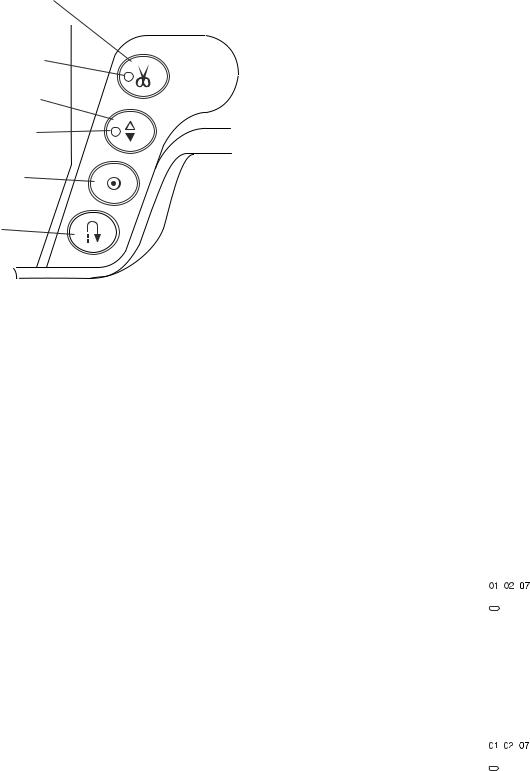
1
5
2
6
3
4
Function Buttons
1 Thread cutter button
Press this button after finishing sewing and the machine will trim the threads.
The LED signal blinks while cutting the threads. 5 Thread Cutter Signal
NOTES:
The auto thread cutter does not work if the presser foot is raised.
The auto thread cutter will work well with normal sewing threads #30 or finer.
Use the thread cutter on the face plate to cut the specialized or thick threads if the auto thread cutter does not work well. When starting the next seam, pull the needle thread to pick the bobbin thread up and draw them to the back and under the foot.
Clean the auto thread cutter mechanism regularly to avoid malfunction due to built up lint.
Avoid using a paper spool when it begins to empty since it will not unwind smoothly. It may cause the thread to bunch or slip when using the auto thread cutter.
2 Up/Down needle button
Press this button to bring the needle bar up or down. The LED signal will turn on when the needle is down. The LED signal will turn off when the needle is up.
The machine will stop with the needle up or down depending on the needle position determined by this button.
The machine will always stop with the needle up after auto thread cutting or buttonhole stitching.
6 LED signal
3 Auto-Lock button
When stitch pattern 01, 02 or 07 
 has been selected, the machine will immediately sew locking stitches
has been selected, the machine will immediately sew locking stitches
and automatically stop when the auto-lock button is pressed. When sewing all other stitches, the machine will sew locking stitches at the end of the pattern being sewn and automatically stop.
4 Reverse button
When stitch pattern 01, 02 or 07 
 has been selected, the machine will sew in reverse while the reverse button is pressed.
has been selected, the machine will sew in reverse while the reverse button is pressed.
If you press the reverse button when sewing all other stitches, the machine will immediately sew locking stitches and automatically stop.
5
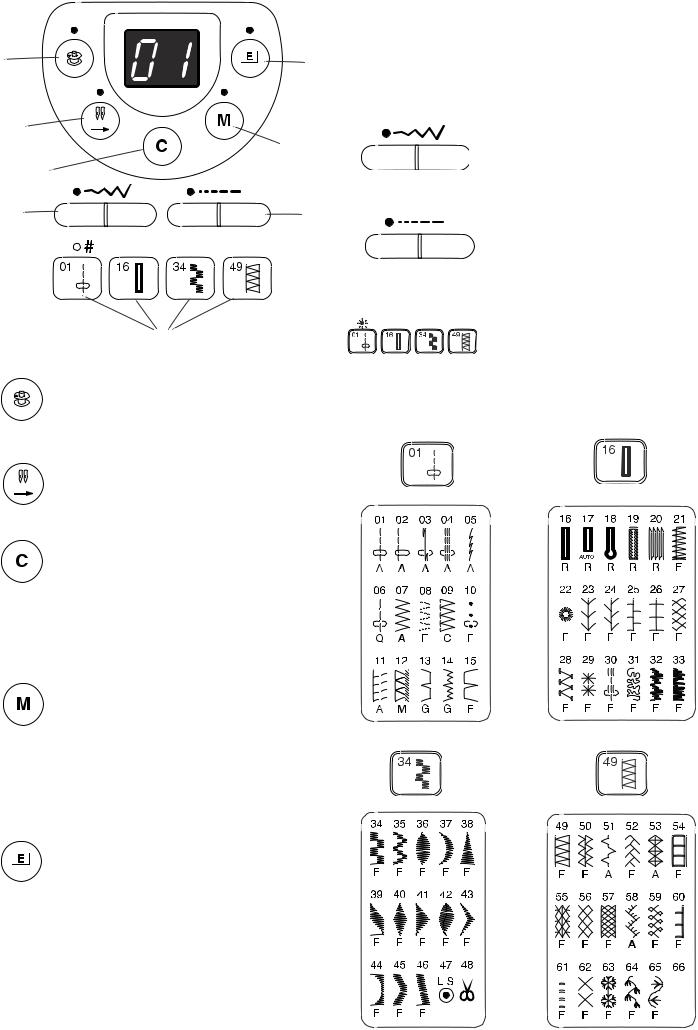
|
|
|
Function Buttons |
|
1 |
|
|
5 |
|
2 |
|
|
6 |
Stitch width adjusting button: |
|
|
4 |
||
|
|
Press this button to alter the stitch |
||
|
3 |
|
||
|
|
width. |
||
|
|
|
||
6 |
|
|
7 |
|
|
|
|
7 |
Stitch length adjusting button: |
|
|
|
Press this button to alter the stitch |
|
|
|
|
length. |
|
8
1 Bobbin winding button:
Press this button to wind the bobbin.
2 Twin needle button:
Press this button when sewing with a twin needle.
3 Clear button
Press this btton to delete the last pattern programmed.
Holding this button being pressed will delete the entire program.
4 Memory button:
Press this button to memorize programmed pattern combinations.
The previous pattern combination will be replaced by the new combination when pressing this button after programming.
5 Elongation button:
Press this button to elongate satin stitch patterns.
8 Pattern selection buttons
Press one of these buttons until a pattern number of the desired pattern is displayed in the LED window.
6
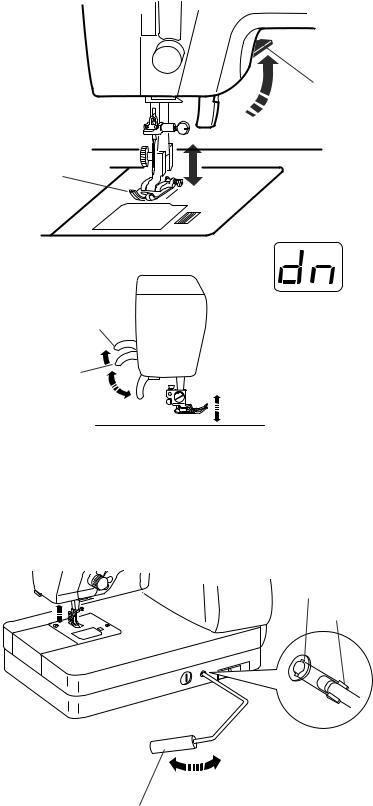
1
2
4
3
3
2
1
Raising and Lowering the Presser Foot
The presser foot lifter raises and lowers the presser foot.
You can raise the presser foot about 6 mm (1/4") higher than the normal up position by exerting more pressure when lifting the presser foot lifter. This allows for easy removal of the presser foot and helps you to place thick fabrics under it.
1Presser Foot Lifter
2Presser Foot
3Up Position
4Extra Lift
NOTE:
If you start the machine with the presser foot up, the LED window will advise you to lower the foot. Lower the foot then restart the machine.
Attaching the Knee Lifter
The Knee Lifter is extremely helpful when sewing applique, patchwork and quilting since it allows you to handle the fabric while your knee controls the presser foot.
Match the ribs on the knee lifter with the notches in the knee lifter socket and insert the knee lifter.
1Knee Lifter
2Ribs
3Notches
Push the knee lifter with your knee to raise and lower the presser foot.
NOTE:
Do not touch the knee lifter while sewing, otherwise the fabric will not be fed smoothly.
7

1
2
3
4
5
6
7
8
9
10
11
12
13
Variety of Presser Feet and Their Uses
1 Zigzag foot A:
This is the most versatile foot. It can be used for various stitches including straight stitches and zigzag stitches. It is designed to achieve firm and neat seam results.
2 Overedge foot C:
This foot is exclusively for overedging. The brush on the foot effectively prevents skipped stitches on the raw edge of fabrics.
3 Rolled hem foot D:
This special foot is for sewing a rolled hem. The curl of the foot helps to form a hem at a constant width.
4 Zipper foot E:
This foot is for sewing zippers. The zipper teeth are guided through the grooves on the bottom of the foot.
5 Satin stitch foot F:
This clear plastic foot is ideal for satin stitches and decorative stitches. The center groove on the bottom of the foot ensures smooth feeding of dense stitches.
6 Craft foot F-2:
This is an open toe satin stitch foot for patchwork and appliqué.
7 Blind hem foot G:
This foot is specially designed for blind hemming. The guide on the foot helps feed the fabric and sew a straight and nearly invisible blind-hem.
8 Cording foot:
This foot is specially designed to hold one or three strands of cording to create braiding.
9 Overcasting Foot M:
This foot is specially designed to simulate professional style overlocking. The wires on the foot effectively prevent the fabric edge from puckering or rolling.
10 1/4” seam foot O:
This foot is useful for patchwork piecing. The guide on the foot maintains an exact 1/4” (0.7 cm) seam allowance.
11 Basting/darning foot P:
This is a special foot for basting. It holds the fabric while taking a stitch, synchronizing with the needle bar movement. This foot can also be used for freemotion embroidery or quilting.
12 Automatic buttonhole foot R:
This foot is for buttonholes and for darning. Place a button in the button holder on the rear of the foot. This automatically sets the buttonhole size.
13 Even feed foot:
This is a special attachment for hard-to-feed materials. This foot effectively prevents fabrics from shifting and puckering. It is great for quilting and matching plaids.
8

|
|
Changing the Presser Foot |
|
|
CAUTION: |
2 |
|
Turn OFF the power switch before changing the foot. |
|
|
Always use the proper foot for the selected pattern. Wrong |
|
3 |
foot can cause the needle to break. |
|
|
|
|
|
To snap off: |
|
|
Raise the needle and presser foot. |
1 |
|
Press the red button on the back of the foot holder and the |
|
|
foot will drop. |
1Red Button
2Foot Holder
3Presser Foot
To snap on:
4
6
Place the presser foot so the pin on the foot lies just under the groove of the foot holder.
5Lower the foot holder to lock the foot in place. Each foot is marked with a letter for identification.
4 Groove
5 Pin
6 Identification Letter
Detaching and Attaching the Foot Holder
WARNING:
2 |
Turn OFF the power switch before detaching or attaching |
|
|
|
the foot holder. |
To detach:
Raise the presser bar and turn the thumbscrew
1
counterclockwise to remove the foot holder. 1 Thumbscrew
2 Foot holder
|
To attach: |
3 |
Align the hole in the foot holder with the threaded hole in |
|
the presser bar and insert the thumbscrew through the |
|
hole. |
2 |
Tighten the thumbscrew by turning it clockwise. |
|
3 Presser Bar |
||
|
1
9
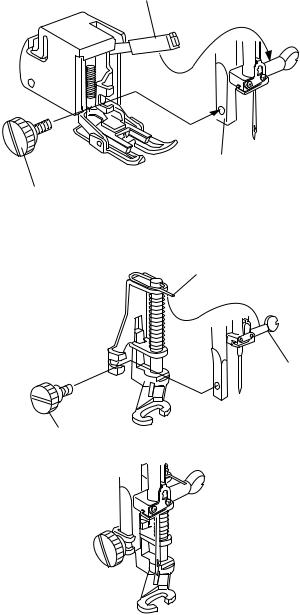
2
3
1
Attaching the even feed foot
Remove the foot holder.
Attach the even feed foot to the presser bar with the lever over the needle clamp screw and secure it with the thumb screw.
1Thumb screw
2Lever
3Presser Bar
2 |
Attaching the darning foot P |
Loosen the thumbscrew and remove the foot holder. Attach the darning foot P to the presser bar putting the pin on the needle clamp screw.
Tighten the thumbscrew firmly with the screwdriver.
|
3 |
|
|
1 |
Thumbscrew |
|
2 |
Pin |
1 |
3 |
Needle Clamp Screw |
10

1
2
3
3
1
2
5 |
5 |
4 |
4 |
|
Winding the Bobbin
Removing the bobbin
Slide the hook cover plate release button to the right, and remove the hook cover plate.
Lift out the bobbin from the bobbin holder.
1Hook Cover Plate Release Button
2Hook Cover Plate
3Bobbin
NOTES:
Avoid using a bobbin when it begins to empty since it may cause thread bunching.
Always use the correct bobbin. Using a wrong bobbin may cause malfunctions.
Setting the spool of thread
Place the spool of thread on the spool pin with the thread coming off the spool as shown. Attach the spool holder, and press it firmly against the spool of thread.
1Spool of Thread
2Spool Pin
3Spool Holder
NOTES:
Avoid using a paper spool when it begins to empty since it will not unwind smoothly. It may cause the thread to bunch or slip when using the auto thread cutter.
Use the large spool holder for ordinary spools, while the small spool holder for small spools.
4Small Spool
5Small Spool Holder
11

z 1
2
x
c
3
v |
4 |
5
b
n 
Winding the bobbin
zPass the thread through the guide on the thread guide post from behind.
1 Thread Guide Post
xPass the thread under the bobbin winding tension disk.
2 Bobbin Winding Tension Disk
cThread through the hole in the bobbin from the inside to the outside.
Put the bobbin on the bobbin winder spindle. 3 Bobbin Winder Spindle
vPush the bobbin winder stopper to the left. Hold the free end of the thread in your hand and press the bobbin winding button.
Press the bobbin winding button again to stop the bobbin when it has made several turns, and cut the thread close to the hole in the bobbin.
4 Bobbin Winder Stopper
5 Bobbin Winding Button
bPress the bobbin winding button again. When the bobbin is fully wound, the machine will stop automatically.
nReturn the bobbin winder stopper to its original position, and cut the thread.
NOTE:
This machine has an exclusive motor for bobbin winding, which allows you to wind the bobbin while stitching.
12

|
Inserting the bobbin |
|
z |
|
|
|
z Place the bobbin in the bobbin holder with the |
|
|
thread running off counterclockwise. |
|
1 |
1 |
Thread |
2 |
Bobbin Holder |
|
2
x |
x Guide the thread into notch (A) on the front of the |
|
bobbin holder. |
(A)
c
c Draw the thread to the left, sliding it between the tension spring blades.
v |
v Continue to draw the thread lightly until the thread |
|
slips into side notch (B). The bobbin should turn |
|
counterclockwise when pulling the bobbin thread. If |
|
not, reverse the bobbin and re-thread. |
(B)
b |
3 |
b Pull out about 10 cm (4") of thread to the rear. |
|
Refer to the threading chart shown on the hook |
|||
|
|
||
|
|
cover plate. |
|
|
|
Reattach the hook cover plate. |
|
|
|
3 Threading Chart |
13

1 z
 v c
v c
2
x
 n
n 
b
m
, 
c
3
v
4
Threading the Machine
Raise the presser foot lifter. Press the up/down needle button twice to raise the needle to its highest position.
zPass the thread through the guide on the thread guide bar from behind.
1 Thread Guide Bar
x Pass the thread through the right thread guide. 2 Right Thread Guide
cHold the upper thread with both hands as shown and slip it under the thread guide plate.
3 Thread Guide Plate
vDraw the thread toward you and pass it into the left thread guide. Draw the thread along the right channel.
4 Left Thread Guide
14
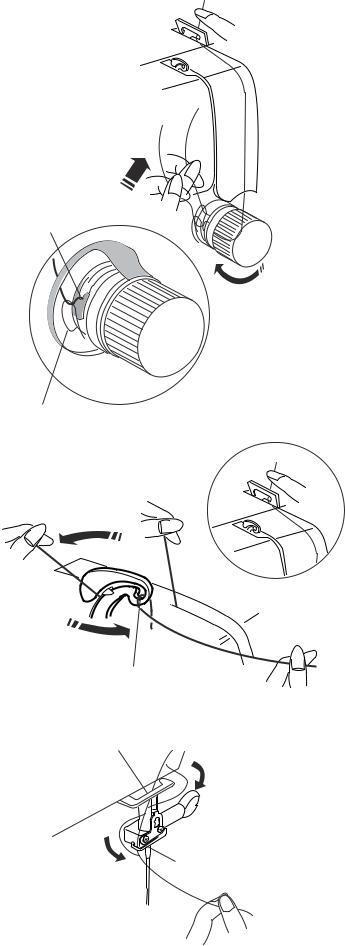
b
6
5
n
7
8
m
,9
. 
Threading the Machine (continued)
bDraw the thread down and around the tension dial from the right to the left. While holdin the thread beside the left thread guide, pull the thread up to insert it between the tension disks and under the loop of the check spring.
Be sure that the thread is coming out from notch of the disk.
5 Check Spring
6 Notch
nFirmly draw the thread up to the take-up lever and down into its eye from the right to the left, while holding the thread beside the left thread guide.
7 Eye of the Thread Take-up Lever
mDraw the thread down through the lower thread guide from the right.
8 Lower Thread Guide
,Slip the thread behind the needle bar thread guide on the left.
9 Needle Bar Thread Guide
.Thread the needle from front to back by hand or use the automatic needle threader.
15

Automatic Needle Threader
Raise the needle to its highest position by pressing the up/down needle button twice. Turn the power switch off.
Lower the presser foot.
z |
z Depress the needle threader knob as far as it will go. |
|
|
The hook comes out through the needle eye from |
|
|
behind. |
|
|
1 |
Needle Threader Knob |
|
2 |
Hook |
|
1 |
|
2 |
x |
x Draw the thread down around the threader guide and |
|
under the hook. |
|
3 Threader Guide |
2
3
c c Release the threader knob slowly while holding the
|
thread end with your hand. A loop of the thread is pulled |
|
4 |
up through the needle eye. |
|
4 Loop of Thread |
||
|
v |
v Remove the loop from the threader and pull out |
|
the thread end from the needle eye. |
NOTES:
The automatic threader works well with the threads #50-90 and needles #11-16, including the blue tipped needle.
The automatic needle threader cannot be used for threading the twin needle.
If the hook fails to pull a loop of the thread, check the needle and its setting.
16
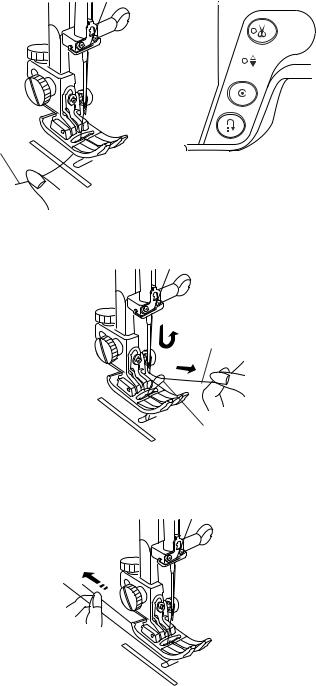
z
2 

1
x
1
3
c
Drawing Up the Bobbin Thread
zRaise the Presser Foot Lifter.
Hold the needle thread with your finger and press the up/down needle button twice to pick up the bobbin thread.
1 Needle Thread
2 Needle Up/Down Button
xDraw up the needle thread to bring up a loop of the bobbin thread.
3 Bobbin Thread
cSlide 10 cm (4") of both threads to the back under the presser foot.
17

|
Changing Needles |
|
z |
Raise the needle by pressing the up/down needle button |
|
1 |
and lower the presser foot. |
|
|
Turn off the power switch. |
|
|
z Loosen the needle clamp screw by turning it |
|
|
counterclockwise. |
|
|
Remove the needle from the clamp. |
|
2 |
1 |
Needle Clamp Screw |
|
|
|
x |
x Insert a new needle into the needle clamp with the |
|
|
flat side of the needle to the rear. |
|
|
When inserting the needle into the needle clamp, push it |
|
3 |
up against the stopper pin and tighten the needle clamp |
|
screw firmly. |
||
2 |
2 |
Stopper Pin |
|
||
|
3 |
Flat Side |
4
To check needle straightness, place the flat side of the needle onto something flat (a needle plate, glass etc.) The gap between the needle and the flat surface should be consistent.
Never use a blunt needle. 4 Gap
|
CAUTION: |
|
|
|
|
|
Always make sure to turn the power switch off and |
||||
|
disconnect the machine from power supply before |
||||
|
changing the needle. |
|
|
||
Fabric and Needle Chart |
|
|
|
||
WEIGHT |
FABRIC |
TYPE of NEEDLE |
NEEDLE SIZE |
||
Very Light |
Chiffon, Georgette, Fine Lace, Organdy |
Universal |
9 (65) |
||
|
Net, Tulle |
Ball Point |
9 (65) |
||
Light |
Batiste, Voile, Lawn, Pure Silk, Crepe de Chine, |
Blue Tipped Needle |
11 (75) |
||
|
Sheer Crepe, Chambray, Handkerchief Linen, |
Universal |
11 (75) |
||
|
Gingham, Challis, Percale, Wool Crepe, Peau de Soie, |
|
12 |
(80) |
|
|
Taffeta, Satin, Silk Surah, Satin-backed |
|
|
|
|
|
Crepe, Qiana |
|
|
|
|
|
|
|
|
||
|
Single Knits, Jersey, Swim wear, and Tricot |
Blue Tipped Needle |
11 (75) |
||
|
|
Ball Point |
11 (75) |
||
|
|
|
|
||
|
Leather Suede |
Wedge Point |
11 (75) |
||
|
|
Leather Needle |
|
|
|
|
|
|
|
|
|
Medium |
Flannel, Velour, Velvet, Muslin, Velveteen, |
Universal |
14 |
(90) |
|
Poplin, Corduroy, Broadcloth, Linen, Chintz, |
|
|
|
||
|
Gabardine, Felt, Terry, Burlap, Quilted Fabrics |
|
|
|
|
|
|
|
|
|
|
|
Double Knits, (synthetic and natural) Stretch |
Ball Point |
14 |
(90) |
|
|
Velour, Stretch Terry, Sweater Knits |
|
|
|
|
|
|
|
|
|
|
|
Leather, Vinyl, Suede |
Wedge Point |
14 |
(90) |
|
|
|
Leather Needle |
|
|
|
|
|
|
|
|
|
Heavy |
Denim, Sailcloth, Ticking |
Denim Needle |
16 |
(100) |
|
|
|
|
|
||
Double Faced Wool, Heavy Coating, Fake Fur, |
Universal |
16 |
(100) |
||
|
|||||
|
Drapery Fabrics |
|
|
|
|
|
|
|
|
|
|
|
Leather, Suede |
Wedge Point |
16 |
(100) |
|
|
|
Leather Needle |
18 |
(110) |
|
Very Heavy |
Canvas, Duck, Upholstery Fabrics |
Universal |
16 |
(100) |
|
|
Topstitching for Special Finish |
Topstitching Needle |
14 |
(90) |
|
18
